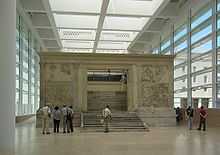Museum of the Ara Pacis
| Museum of the Ara Pacis | |
|---|---|
| Museo dell'Ara Pacis | |
| Established | 2006 |
| Location | Lungotevere in Augusta (corner with Via Tomacelli) – 00100 Rome, Italy |
| Director | Claudio Parisi Presicce |
| Website |
www |
The Museum of the Ara Pacis belongs to the Sistema dei Musei in Comune of Rome (Italy); it hosts the Ara Pacis of Augustus, inaugurated on January 30, 9 BC
Structure



Designed by Richard Meier, built in steel, travertine, glass and plastes, the museum is the first great architectural and urban intervention in the historic centre of Rome since the Fascist era: it is a structure with a triumphal nature, clearly alluding to the style of imperial Rome. Wide glazed surfaces allow to admire the Ara Pacis with uniform enlightenment conditions.
The white colour is the trade-mark of Richard Meier, while the travertine plates decorating part of the building are a consequence of in-progress changes (aluminum surfaces were formerly intended), after a design review following controversies with some nostalgics of the old case, built in 1938 by architect Vittorio Ballio Morpurgo.
The challenging design of Meier wants to assert itself in the very hearth of the town, becoming a nerve and transit centre. The complex was intended to include a crosswalk with an underpass linking the museum to the Tiber; presently the underpass design seems completely abandoned.[1]
History
The building, designed by architect Richard Meier, has been inaugurated and opened to the public after seven years of works, on April 21, 2006 (the traditional date of the foundation of Rome).
In the night between May 31 and June 1, 2009, unknown men stained the white outer wall with green and red paint and placed a toilet bowl at the feet of the wall.
On December 12, 2009 a group of activists of Earth First!, at the same time of the Copenhagen Summit, colored with green the water of the fountain and affixed on the side facing Via Tomacelli a banner saying «Earth First! Act Now». The officers and the employees of the museum intervened immediately removing the banner and emptying the fountain.
Criticisms
The building has collected conflicting viewpoints. The New York Times judged it openly a flop, while the famous art critic and polemicist Vittorio Sgarbi defined it «a Texas gas station in the very earth of one of the most important urban centres in the world», as well as the first step towards an "internationalisation" of the city of Rome. Nonetheless, the ruling was not unanimous at all[2] and, for instance, Achille Bonito Oliva praised Meier's design.[3]
In November 2013 a leaky roof led to unwanted water in the new museum building during heavy rain. Staff members had to use buckets to remove water from the top of the altar.[4]
During one of his first declarations after being elected Mayor of Rome (April 2008), Gianni Alemanno announced his purpose to remove Meier's case, that the Roman right wing always disapproved. However, Alemanno himself later pointed out that the removal was not a priority of his politic programme.[5]
Notes
- ↑ Non si abbatterà il muretto dell'Ara Pacis arriva lo stop della soprintendenza Lilli Garrone on the Corriere della Sera
- ↑ Giannino Cusano. "Il progetto di Richard Meier per l'Ara Pacis a Roma: perché si!".
- ↑ Interview granted to TG3 the day after the declarations of the Mayor Gianni Alemanno.
- ↑ http://archaeology.org/news/1552-131125-rome-ara-pacis-flood
- ↑ Non si abbatterà il muretto dell'Ara Pacis arriva lo stop della soprintendenza Lilli Garrone on Corriere della Sera
Bibliography
- Federico Del Prete, Ara Pacis, Punctum, Rome 2006
External links
- Official website
- Musei in Comune official website
- Photographic documentation about the Museum of the Ara Pacis
| ||||||||||||||||||||||||||||